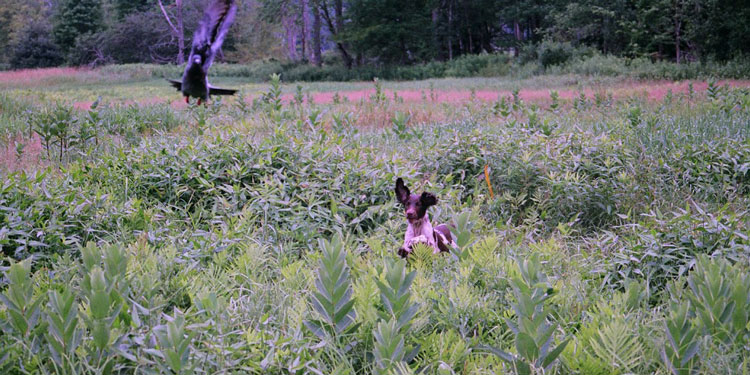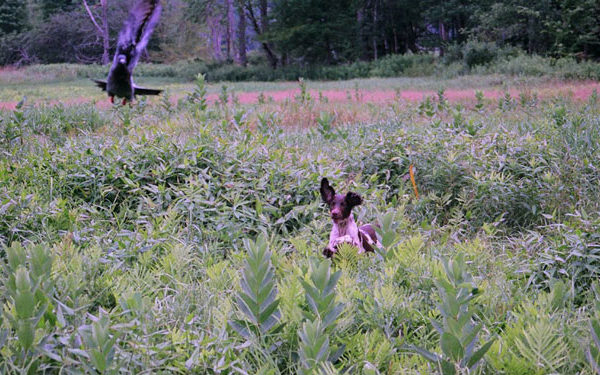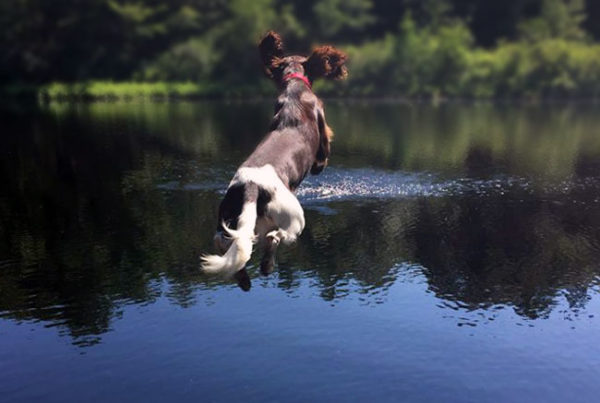
In most of the situations that we send our gun dogs to retrieve, the task is completed relatively quickly and with little fuss. The majority of the falls will be properly “marked” and should the game be dead, our pups find will be relatively easy. However, at times we get into a predicament where that allusive Rooster was just peppered and has glided in for a “cripple” landing. Although the dog may have marked the fall area well, chances are the bird will have taken off on foot before the dog is able to get to the find area. Thus, making it imperative that we start our spaniels on developing their instinct to track and trail early in life.
Unfortunately, none of us owners have the ability to track and trail cripple game. Some youngsters have the natural tracking ability and desire that shows it self early in life. Others pick it up later as they start to mature. Some must be encouraged through subconscious training and exposure. It is so nice to have a puppy pick it up on his own in the woods as he runs about in search of interesting scents. You can see the dog hit the trail and begin to search a trail to find where it leads.
The good natural ones have no trouble at all. They put their noses right down on the ground cover and go just as far as it leads. You will see quite quickly how they love this game of hide and seek. Not knowing why or for what reason, but they find it such an interesting and compelling game.
Flushing dogs can begin to learn tracking at a young age. Once they are handling live and dead pigeons, we can begin training. Teaching trailing at a young age educates the dog to trust and depend on its nose for the success in producing game.
To begin, we always work the spaniel into the wind, giving them every opportunity to be successful during this stage of schooling. The first dozen or so trailing attempts should be short and sweet. Remember the golden rule, “keep it simple”. Choose a day when the grass is damp from the morning dew or has been lightly moistened by an overnight shower. This will help hold the sent on the trail you set down, making things easier for your young spaniel. The cover in the field should only be high enough to conceal the bird out of sight.
Keep your spaniel in a confined area where they will not see you set up the training situation. Put a pair of rubber boots on to keep the spaniel from tracking your own foot scent. Walk down the outer edge of a field. Make a sharp turn in an upside down “J” pattern towards the center of the field.
Mark the starting point of the trail by pulling and dropping a few pinfeathers from a live pigeon. You may wish to tie a piece of orange surveyors’ ribbon to the short cover. This will give the precise location of where the trail will start. Holding a live pigeon by the wing tips. Guide the direction you wish the trail to go as the pigeon walks along the ground. Stop the bird periodically and force the body to the ground, then continue on with the track only going a short distance to start. Once the trail has been laid, you can choose to give a dead bird at the end of the trail or a clipped winged pigeon, whichever your young spaniel is more comfortable in handling for a retrieve.
Do not overdo the training of trailing. Mixing it up between dead, clipped wings and live fliers. This will maintain good attitude about trailing and keep there flush bold. Keep the spaniel guessing, as time progresses and confidence builds. Make trails longer and more difficult by the use of terrain and denser cover.
When your dog has shown good solid development it is time to take a clipped winged and shackled duck and toss it into the field. Give the duck several minutes to work out a trail for your spaniel and settle down. Get your dog and let him work out the trail and finally retrieve the duck. Eventually, move on to an unshackled duck for trailing. This will encourage your spaniel to work a track faster. They must move quickly if they want to catch up to scurrying game. I have seen many spaniels not work a trail quick enough and lose the opportunity to flush running game!
Now that you can see the spaniel is working this stage of trailing with more confidence and speed, use trailing to get you spaniel adapted to heavier cover such as briers, berry bushes and wild roses. This is where the birds are most likely to be on the average day out hunting. Believe me, after a few sessions of trailing a bird into heavy cover your spaniel will have very little problem busting in to search out game.
The final stage of trailing should conclude with calling your spaniel off an old trail laid out the day before. Once he complies with the recall command and lay off an old trail, reward him by having him find a dead bird that you have dropped in front of you while he was starting to take interest in that old trail. You can start to teach your spaniel the difference between a fresh trail and an old one by simply lying a new trail in the general location of a trail lay the day before. However, do not overdo the call off on an old trail. I would suggest calling off on a trail about one out every five, we want to maintain good solid attitude about trailing. Enjoy your gundog!





